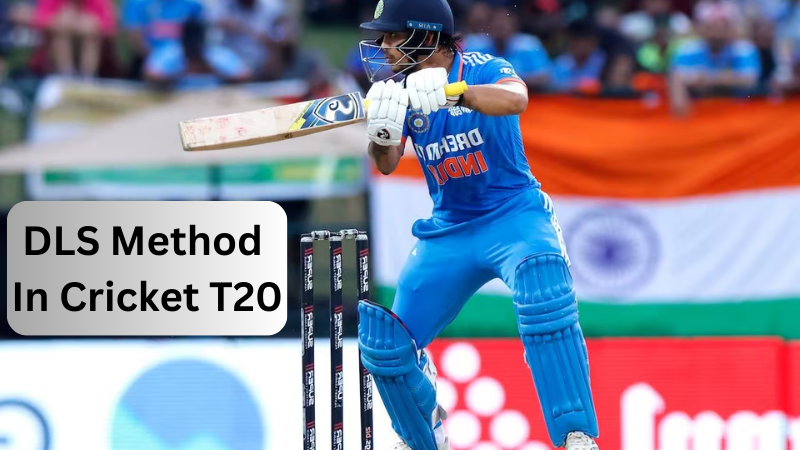The Duckworth-Lewis-Stern (DLS) method is a mathematical formulation crafted to determine the target score for the team batting second in a limited-overs cricket match that experiences interruptions due to weather or other circumstances. It is commonly used in T20 internationals when play is disrupted by weather or other external factors.
What is the DLS Method?
The Duckworth-Lewis-Stern (DLS) method is a mathematical approach utilized in cricket when a match experiences interruptions due to weather or other circumstances. It calculates the target score for the team batting second in a limited-overs cricket match.
Originally devised by statisticians Frank Duckworth and Tony Lewis, Professor Steven Stern later refined the DLS method. It revolves around the concept of ‘resources,’ a combination of overs (balls to be bowled) and wickets (remaining players) that a team still possesses. This method employs these resources to adjust the target score in response to the impact of interruptions.
Essentially, the DLS method aims to ensure a fair game by considering what might have occurred if the match had not been interrupted. Widely applied in both international and domestic cricket, it serves as a tool to maintain fairness in the game.
What is the History and Creation of the DLS Method?
Initially employed in a match between Zimbabwe and England in 1996-97, the DLS method received approval from the ICC in 1999. Statisticians Frank Duckworth and Tony Lewis were its original inventors. Following their retirement, Professor Steven Stern assumed responsibility for the method, and in November 2014, it was renamed the Duckworth-Lewis-Stern method.
What is the Reason For Following the Duckworth-Lewis Method?
Cricket, being widely played worldwide and considered the third most popular sport after football and the Rugby World Cups, faces interruptions due to weather. In such situations, the Duckworth-Lewis Method is implemented to maintain the enjoyment of the game.
What is the Difference between the Par Score and the Target Score?
The par score is the total that a chasing team should have reached at the time of interruption, considering a specific number of wickets lost. On the other hand, the target score is the revised score that a team is required to achieve after an interruption. While the target score remains constant, the par score varies based on the number of wickets lost.
How does the DLS (Duckworth-Lewis-Stern) Method Calculate?
The calculation of the target score involves a formula expressed as Team 2’s par score = Team 1’s score x (Team 2’s resources/Team 1’s resources). The only two factors considered during the match after an interruption are the remaining overs and remaining wickets. Frank Duckworth and Tony Lewis created a chart based on these resources, indicating how many resources are left on the batting side in different situations.
In conclusion, the DLS method plays a pivotal role in determining the winner in unavoidable situations for the team batting second in limited-over cricket. It strives to establish a level playing field by setting the target based on the remaining resources, namely overs and wickets, for both teams.
READ MORE: ICC Cricket World Cup Warm Up Matches
How Does DLS Work in T20 Cricket?
The DLS method uses a complex algorithm that considers the following factors:
- Number of overs lost due to interruption
- Number of wickets in hand
- The projected run rate of the batting team
Based on these inputs, the DLS method calculates a revised target score for the team batting second in a T20 match affected by interruptions.
The goal is to ensure both teams have the opportunity to bat for the same number of overs while factoring in their projected scoring rates. This allows for a fair result even if the match can’t be completed in full.
What are the Key Features of DLS in T20?
Key Features of DLS in T20:
- Matches must be at least 5 overs per side to constitute a game
- The team batting second is given a revised DLS target to chase based on the interruption
- DLS calculations account for wickets lost and the current run rate
- The target is adjusted ball-by-ball following any delays
- Winning margins are decided by run rate if targets are equal
What are the Applications in Major T20 Tournaments?
The ICC endorsed the DLS method and applied it in high-profile T20 tournaments, including the IPL, PSL, BBL, CPL, and WT20 events. It aims to ensure minimal advantage for the team batting first if weather or other issues arise.
While complex, DLS creates a fairer platform when full 20-over contests aren’t possible. Understanding the basics helps fans better interpret revised targets and results on the DLS method.
Conclusion
In the fast-paced realm of T20 cricket, where each delivery can sway the game’s balance, the Duckworth-Lewis-Stern (DLS) method serves as a symbol of fairness and predictability in the face of weather and interruptions. It guarantees that no team faces unjust disadvantages due to uncontrollable factors.
The DLS method, with its intricate calculations and consideration of ‘resources,’ brings a unique fusion of mathematics and sportsmanship to the exhilarating world of T20 cricket. It goes beyond being just a method; it’s a testament to the spirit of cricket, played not only on the field but also in the minds of strategists and statisticians. In essence, the DLS method is an integral aspect of modern T20 cricket, ensuring each match remains a fair competition until the final ball. For more interesting knowledge about cricket, follow and visit our website t20cricketworldcup.info.
FAQs for DLS Method In Cricket T20
How Many Overs are Required for DLS in T20?
five overs are required for DLS in T20 matches.
What is the DLS Method in the T20 Table?
The alternative table is created using scoring rates observed in international Twenty20 matches.
What is Won by the DLS Method in Cricket?
A mathematical formula crafted to determine the target score for the team batting second in a limited-overs cricket match that experiences interruptions due to weather or other circumstances.
